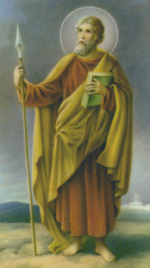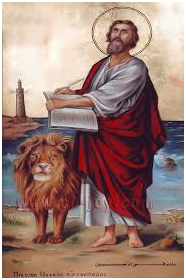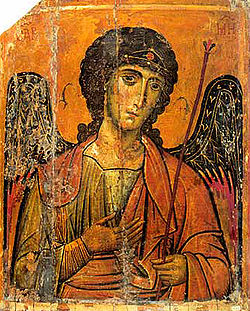Our Saints
The book of Acts mentions a Mark, or John Mark, a kinsman of Barnabas. The house of his mother Mary was a meeting place for Christians in Jerusalem. When Paul and Barnabas, who had been in Antioch, came to Jerusalem, they brought Mark back to Antioch with them and he accompanied them on their first missionary journey, but left them prematurely and returned to Jerusalem. When Paul and Barnabas were about to set out on a second missionary journey, Barnabas proposed to take Mark, but Paul thought him unreliable, so that eventually Barnabas made one journey taking Mark, and Paul another journey taking Silas. Mark is not mentioned again in Acts. However, it appears that he became more reliable, for Paul mentions him as a trusted assistant in Colossians 4:10 and again in 2 Timothy 4:11.
The Apostle Peter had a co-worker whom he refers to as “my son Mark”. Papias, an early second century writer, in describing the origins of the Gospels, tells us that Mark was the “interpreter” of Peter, and that he wrote down (“but not in order”) the stories that he had heard Peter tell in his preaching about the life and teachings of Jesus.
The Gospel of Mark, in describing the arrest of Jesus speaks of a young man who followed the arresting party, wearing only a linen cloth wrapped around his body, whom the arresting party tried to seize, but who left the cloth in their hands and fled naked. It is speculated that this young man was the writer himself, since the detail is hardly worth mentioning if he were not.
Tradition has it that after the death of Peter, Mark left Rome and went to preach in Alexandria, Egypt, where he was eventually martyred.
It is natural to identify the John Mark of Acts with the Gospel-writer and interpreter of Peter, and this identification is standard in liturgical references to Mark. However, “Mark” is the commonest of Latin first names, and they may well have been separate persons.
Mark’s symbol in art is a Lion, usually winged.
PRAYER
Almighty God, who by the hand of Mark the evangelist have given To your Church the Gospel of Jesus Christ the Son of God: We thank you for this witness, and pray that we may be firmly grounded in its truth; through Jesus Christ our Lord, who lives and reigns with you and the Holy Spirit, one God, for ever and ever.
 Saint Luke the Evangelist – October 18
Saint Luke the Evangelist – October 18
Saint Luke was born a Greek and a Gentile in the Greek city of Antioch in ancient Syria. Luke is the only Gentile to have written books in the Bible. He is the author of the third Gospel and the Acts of the Apostles. His writings have been proven to be historically accurate.
Luke was a physician by profession. He had become a disciple of the apostle Paul and accompanied Paul on his missionary journeys. Luke is mentioned three times in Paul’s letters, once as the “beloved physician” (Col. 4:14).
Although Luke was not an ‘eyewitness’ of the events of Jesus’ life, he relied on the various existing sources, in particular the Gospel of Mark.
In his first book, the Gospel according to Luke, he vividly records the story of the life of Christ, his preaching and miracles, his suffering, death and resurrection. Luke emphasizes Christ’s compassion for sinners and for those who suffer. He highlighted re relationships Jesus had with women.
In his second book, the Acts of the Apostles, Luke’s Christian ministry can be followed as he tells how the good news was spread throughout the Roman Empire.
It is thought that Luke wrote his Gospel about the year A.D.60 while Paul was in prison in Caesarea and that the book of Acts in the next two years, during Paul’s imprisonment in Rome. Both books are addressed to the same person, Theophilus.
It is believed that Luke lived a long life and died c 74 at the age of 84.
Saint George – April 23
 Saint George (Latin: Georgius; c. 275/281 – 23 April 303 AD), was born in Lydda in Palestine,and was a soldier in the Roman army, later venerated as a Christian martyr.
Saint George (Latin: Georgius; c. 275/281 – 23 April 303 AD), was born in Lydda in Palestine,and was a soldier in the Roman army, later venerated as a Christian martyr.
As a Christian Soldier in the army of the Roman Emperor Diocletian, St George boldly proclaimed his allegiance to Christ. This ultimately cost him his life when he urged Emperor Diocletian to stop vehemently persecuting Christians.
St George was finally beheaded on 23rd April, 303 AD. For diligently keeping the faith.
Many stories are recounted about St. George slaying a legendary dragon with a woman looking on. The dragon is symbolic of Satan being defeated as described in Rev. 12:9. The woman represents God’s grace and truth which is victorious in the battle.
We annually commemorate St. George on the anniversary of his death, April 23rd.
St. Paul “The Conversion of St. Paul” January 25
Paul the Apostle (c. AD 5 – c. AD 67) is perhaps the most influential early Christian missionary and leader of the first generation of Christians. But he didn’t start out that way . . . He was born Saul, a Greek-speaking Roman Jew and devout Pharisee, a group devoted to preserving religious tradition and stamping out the new Christianity. He had believers tortured and condemned; he held the coats of those who stoned the first Christian martyr to death. So what happened? While he was taking a group of condemned Christians to Damascus, a vision of Jesus appeared to him, asking “Why do you persecute me?” He fell down blind, and when his sight was restored three days later, he converted to Christianity, took the name Paul, and began preaching that Jesus was the messiah! Paul spent the second half of his life building up the faith he’d started out to destroy. He traveled throughout the ancient world, establishing churches where ever he went; his letters to these congregations form half the Bible’s New Testament. His inspired preaching of Christ’s Gospel won converts everywhere and his writings have had a profound effect on Christian thinking. Paul was passionate about his beliefs, and was imprisoned, tortured, and finally martyred for them.
St. Stephen the Martyr – December 26
St. Stephen, killed in 35 A. D. is considered the first Christian Martyr. He was one of seven men specially selected by the disciples to distribute food among the poor so they themselves were free to teach the word of God. Stephen, however, being full of God’s grace and power, also did great wonders and miraculous signs. In this role he came to the attention of members of the synagogue who felt threatened by him. They stirred up people against Stephen saying he was speaking against Moses and the old customs. In replying to false witnesses, Stephen used the history of the Jewish people to show that his accusers were not obeying the laws. Angered they rushed Stephen out of town and began to stone him to death. As he was dying, like Jesus, he prayed for those who killed him.
Feast Day: December 26, traditionally a day when the wealthy English boxed up food for the poor.
Feast Day – September 29
Angels, Greek Word for ‘messengers’. These messengers from God can be visible or invisible and may take human forms.
The prefix ‘arch’, suggests a chief, principal or great angel (1 Thess. 4:16).
Michael is the angel above all angels (Daniel 10:13). His name in Hebrew means ‘who is like unto the Lord’.
He is God’s messenger of law and judgment.
In Revelation (Rev. 12:7-12), the last book of the Bible, Michael leading God’s armies of angels (heavenly hosts) will be locked in the final, great battle with Satan, the great dragon. Satan will be defeated along with all the forces of evil.
St. Michael, the Archangel, usually depicted with a sword slaying a serpent, symbolizes the force of good over the force of evil.
Patron saint of police officers.
St. Thomas: Born: 1st century (birth year unknown) – Died in 72 AD
 His feast day is July 3rd
His feast day is July 3rd
Patron of Architects
Declared the “Apostle of India” by Pope Paul VI in 1972
St. Thomas was a First Century Jew, thought to have been a carpenter from Galilee, and of humble origins when he was called to be one of the twelve Apostles. He was a dedicated but impetuous follower of Christ. When Jesus said He was returning to Judea to visit His sick friend Lazarus, Thomas immediately encouraged the other Apostles to accompany Him on the trip which involved certain danger and possible death because of the mounting hostility of the authorities. At the Last Supper, when Christ told His Apostles that He was going to prepare a place for them to which they also might come because they knew both the place and the way, Thomas pleaded that they did not understand and received the beautiful assurance that Christ is the Way, the Truth, and the Life.
Jesus and Thomas as referenced in John 20:24-29
St. Thomas is best known for his role in verifying the Resurrection of his Master. Thomas’ unwillingness to believe that the other Apostles had seen their risen Lord on the first Easter Sunday earned for him the title of “doubting Thomas.” Eight days later, on Christ’s second apparition, Thomas was gently reprimanded for his skepticism and was furnished with the evidence he had demanded – seeing in Christ’s hands the point of the nails and putting his fingers in the place of the nails and his hand into His side. This convinced St. Thomas of the truth of the Resurrection and he exclaimed: “My Lord and My God,” making a public Profession of Faith in the Divinity of Jesus.
Tradition says that at the dispersal of the Apostles after Pentecost this saint was sent to evangelize the Parthians, Medes, and Persians; he ultimately reached India, carrying the Faith to the Malabar coast, which still boasts a large native population calling themselves “Christians of St. Thomas.” St. Thomas was Martyred by shedding his blood for his Master, speared to death at a place called Calamine.

